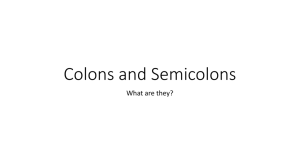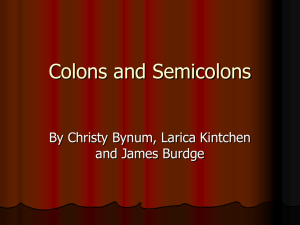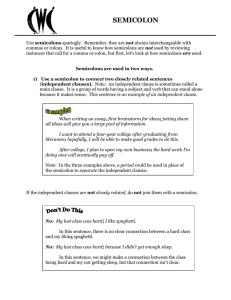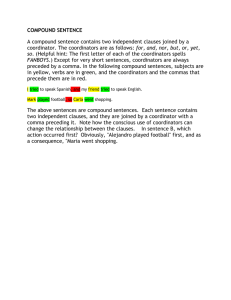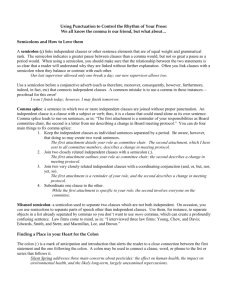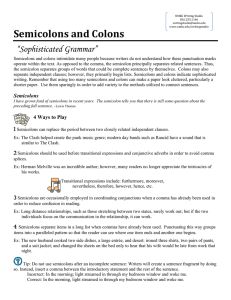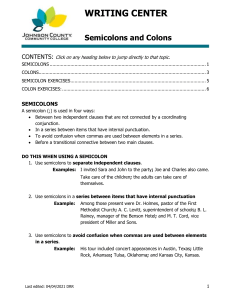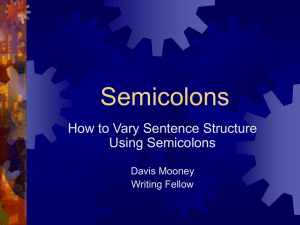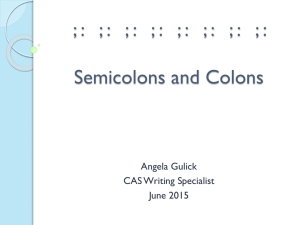Punctuation Review: Colons and Semicolons
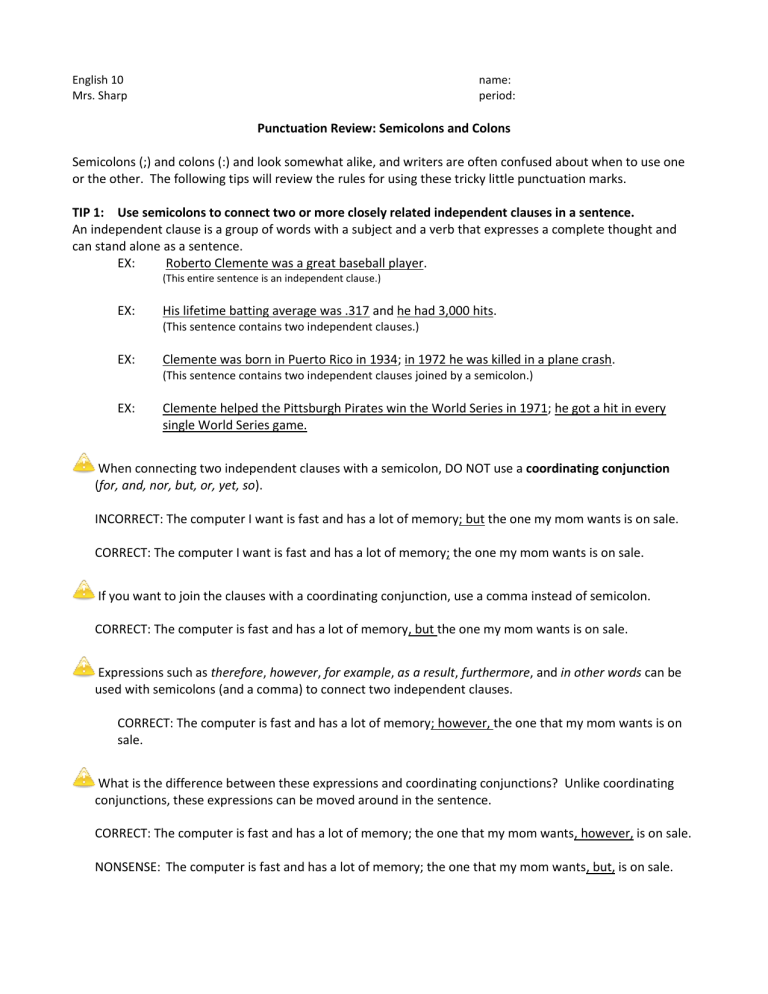
English 10
Mrs. Sharp name: period:
Punctuation Review: Semicolons and Colons
Semicolons (;) and colons (:) and look somewhat alike, and writers are often confused about when to use one or the other. The following tips will review the rules for using these tricky little punctuation marks.
TIP 1: Use semicolons to connect two or more closely related independent clauses in a sentence.
An independent clause is a group of words with a subject and a verb that expresses a complete thought and can stand alone as a sentence.
EX: Roberto Clemente was a great baseball player.
(This entire sentence is an independent clause.)
EX: His lifetime batting average was .317 and he had 3,000 hits.
(This sentence contains two independent clauses.)
EX: Clemente was born in Puerto Rico in 1934; in 1972 he was killed in a plane crash.
(This sentence contains two independent clauses joined by a semicolon.)
EX: Clemente helped the Pittsburgh Pirates win the World Series in 1971; he got a hit in every single World Series game.
When connecting two independent clauses with a semicolon, DO NOT use a coordinating conjunction
(for, and, nor, but, or, yet, so).
INCORRECT: The computer I want is fast and has a lot of memory; but the one my mom wants is on sale.
CORRECT: The computer I want is fast and has a lot of memory; the one my mom wants is on sale.
If you want to join the clauses with a coordinating conjunction, use a comma instead of semicolon.
CORRECT: The computer is fast and has a lot of memory, but the one my mom wants is on sale.
Expressions such as therefore, however, for example, as a result, furthermore, and in other words can be used with semicolons (and a comma) to connect two independent clauses.
CORRECT: The computer is fast and has a lot of memory; however, the one that my mom wants is on sale.
What is the difference between these expressions and coordinating conjunctions? Unlike coordinating conjunctions, these expressions can be moved around in the sentence.
CORRECT: The computer is fast and has a lot of memory; the one that my mom wants, however, is on sale.
NONSENSE: The computer is fast and has a lot of memory; the one that my mom wants, but, is on sale.
TIP 2: Use a semicolon to separate items in a series that already contains commas, such as cities and states or dates.
CONFUSING: In his short life, Julien has lived in Hot Coffee, Mississippi, What Cheer, Iowa, Zigzag,
Oregon, and Novelty, Ohio.
Julien visited Truth or Consequences, NM on July 8, 2010, September 24, 2011, May
16, 2012, and March 4, 2013.
BETTER: In his short life, Julien has lived in Hot Coffee, Mississippi; What Cheer, Iowa; Zigzag,
Oregon; and Novelty, Ohio.
Julien visited Truth or Consequences, NM on July 8, 2010; September 24, 2011; May
16, 2012; and March 4, 2013.
TIP 3: Use a colon when you want to break a sentence in a way that calls attention to what follows the punctuation.
Use a colon to introduce a second clause or phrase that helps explain the first clause. If the second clause or phrase is a complete sentence, capitalize the clause following the colon.
Of course you didn’t get the computer to work: It needs to be plugged in first.
His success is attributed to one thing: determination.
Colons can also be used to introduce a list after an independent clause.
There are three kinds of music I like to listen to: rap, bluegrass, and show tunes.
It is by the fortune of God that, in this country, we have three benefits: freedom of speech, freedom of thought, and the wisdom never to use either.
Use a colon to introduce an appositive phrase that ends a sentence. (An appositive phrase is a phrase that renames or describes a noun or pronoun.)
EX: At the end of the day, the gang unmasked the suspect: old Mr. Hansen from the drugstore.
In sentence, “the suspect” is renamed with the appositive phrase “old Mr. Hansen from the drugstore.”
All of these examples have something in common: The colon follows an independent clause. In other words, everything before the colon can stand alone as a sentence. As a general rule, always make sure the text before the colon contains a subject and a verb and forms a complete thought.
INCORRECT: Has Gramps succeeded in burning: the jambalaya, the turnip greens, and the hot-pepper cornbread?
(“Has Gramps succeeded in burning” cannot stand alone as a sentence because it doesn’t express a complete thought.)
CORRECT: Gramps has succeeded in burning dinner: the jambalaya, the turnip greens, and the hotpepper cornbread?
(“Gramps has succeeded in burning dinner” can stand alone as sentence because it has a subject and a verb and it expresses a complete thought.)
PRACTICE #1
In the following sentences, underline the subject once and the verb(s) twice. Then, insert colons and semicolons where appropriate.
1. My mother’s dad had an apple orchard my father’s dad was a lobsterman.
2. What the Red Sox did in 1920 we find unthinkable today they traded Babe Ruth to the New York Yankees.
3. Ms. Fernandez has the best sense of humor of any teacher in the school however she takes her job very seriously.
4. Fabian will eat almost anything but there are three lunches he just can’t stands shepard’s pie, bean casserole, and corn dogs.
5. The After-School Book Circle read a diverse collection of books last month The Wasteland, poems by T.S.
Eliot Beloved, a novel by Toni Morrison and Country of the Pointed Firs, stories by Sarah Orne Jewett.
PRACTICE #2
Proofread each of the following sentences for correct use of colons or semicolons. First, underline the subject once and the verb(s) twice. Then, rewrite each sentence using proper punctuation.
6. On your way home; would you please: buy papaya juice, chicken wire, shoelaces, and a plunger?
__________________________________________________________________________________________
__________________________________________________________________________________________
7. Scottie Javelin’s new album is dull; and it’s expensive too.
__________________________________________________________________________________________
__________________________________________________________________________________________
8. In addition to a $10,000 scholarship: the essay contest winner gets a free European tour, including stops in
Vienna, Austria, Budapest, Hungary, and Helsinki, Finland.
__________________________________________________________________________________________
__________________________________________________________________________________________
